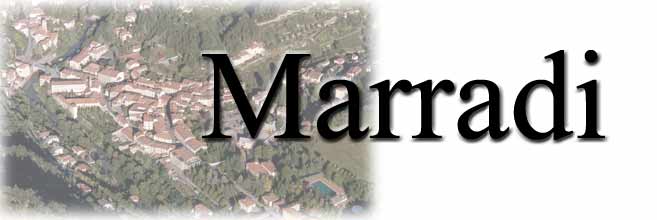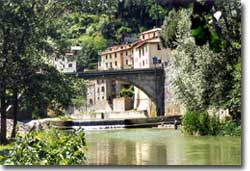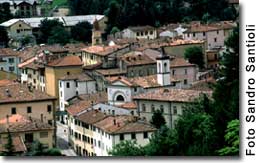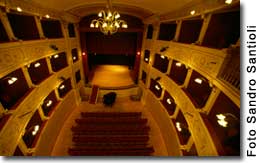
“La valle canora dove si snoda l’azzurro fiume
Che rotto e muggente a tratti canta epopea
E sereno riposa in larghi specchi d’azzurro”
(Marradi - Dino Campana 1885-1932)
Poets' prose still today find reference in the Marradese
territory, so suggestive and attractive for the green of its forests, its
century old chestnut trees, the interchange of rivers and streams, whose
lipid waters (according to ARPAT the cleanest in the Firenze province)
cross uncontaminated valleys, land still virgin, where sky and earth
almost touch.
In an embrace in which the colours of
nature, the magic of the forests and the pureness of the air (this also
considered by ARPAT the cleanest in the Firenze province) make the territory of
Marradi an obligatory destination for nature and culture
lovers.
 The median position of Marradi
between Firenze, Ravenna and the Romagnola Riviera, each reachable by car
and train (with the suggestive and historic Faentina Railway line) make it an
ideal location for those who want to combine environmental tourism with
historical, cultural and resort tourism.
The median position of Marradi
between Firenze, Ravenna and the Romagnola Riviera, each reachable by car
and train (with the suggestive and historic Faentina Railway line) make it an
ideal location for those who want to combine environmental tourism with
historical, cultural and resort tourism.
The
Marradi municipalities are numerous, farm holidays, bed & breakfast,
accommodation facilities immersed in the country, in quiet corners, where
one can pass the days in complete relaxation and
privacy.
Facilities able to welcome every type of
client, from the most demanding to the boy scout, The municipal territory is
crossed by a vast mesh of interesting nature walks, signposted and cared
for by the CAI and SOFT Trekking, usable by foot, maintain bike or
horseback and which often pass notable religious monuments of the X-XI
century.
The naturalistic interests extend also to
the fauna, the return of the wolf, the many hoofed animals, walking in our
woods it is possible to meet “Bambi”.
The
rivers with pure limpid water make this land one of the few Appennine zones rich
in fish from the salmon family.
There are numerous
Abbeys and religious locations in the Marradi Municipality formed from the
strong spirituality during the X and XII
centuries.
Those of most note are the Abbey of
S. Reparata, one of the most important monastic complexes in the territory,
going back to the XI century; of Romanic architecture founded by S. Giovanni
Gualberto, which retains works from the Ghirlandaio
school.
From the same period, the Abbey of Crespino
del Lanome where prestigious frescoes from the XII century are
found.
 To these must be added the Eremo di
Gamogna, which is found in a high plain at roughly 900 metres above sea
level, and the Abbey della Valle also of Romanic architecture founded by S. Pier
Damiano.
To these must be added the Eremo di
Gamogna, which is found in a high plain at roughly 900 metres above sea
level, and the Abbey della Valle also of Romanic architecture founded by S. Pier
Damiano.
A visit to the Rocca del
Castiglionchio is also obligatory, a fortification from the VI century,
today only the recently consolidated central nucleus remains. Its panoramic
position, which covers all the Lamone valley made it a strategic location
from a military point of view. Niccolò Machiavelli cited it more than
once in his writings.
First the dominion of the Guidi
Counts then successively that of the Fiorentina Republic, Marradi maintains a
notable historic centre which presents an urban structure difficult to find in
mountain towns: the houses, the lordly palaces remind one more of the streets of
the historic centre of a city like Firenze, rather than a town in the mountains.
Piazza delle Scalelle is its heart onto which face the Palazzo Comunale
with its arcade, the 1600s Palazzo Fabroni, the Palazzo del Cannone and the
church of Suffragio.
In the underlying square,
other than the palazzo Fabroni and the palazzo Torriani there is the
tower lane, via Fabbrini, where a recently restored antique sundial can be
found. A little further on is the Dominican monastery and the extremely elegant
and delightful Teatro degli Animosi in late 1600s style. Also to note is
the Arcipretale church and the house of the poet Dino
Campana.
Regarding this, in the new Dino
Campana cultural centre, which also contains the municipal library, the tourist
office and the historic archives with documents going back to the period before
the unity of Italy, there is the Campaniani Study Centre, the most
important study centre and collection of documents relative to Dino Campana and
the absolute richest bibliography of the poet. A centre which is a point of
reference for scholars and students.
 Marradi is
the land of Marron Buono (chestnut) and diamond point of the Mugello IGP.
The quality of the Marradi chestnut is recognised internationally as being the
highest.
Marradi is
the land of Marron Buono (chestnut) and diamond point of the Mugello IGP.
The quality of the Marradi chestnut is recognised internationally as being the
highest.
Gastronomy benefits from the myriad of
exquisite recipes based on the chestnut among which stands out the
“torta di Marroni di Marradi” (Marradi Chestnut cake) emblem
of the local gastronomic culture, the recipe for which is jealously conserved
in the memory of the elderly.
It is possible to
taste this deliciousness during the historic and famous “Sagra delle
Castagne” (Chestnut festival) held during the month of October, also
reached by the evocative steam train.
For
the last few decades the local gastronomy has featured, together with the
traditional and delicious Porcino and Ovulo mushroom, game and in
particular wild boar, accompanied by the rediscovered
polenta.
In the month of December the Christmas
Market is held, with the characteristic stalls, a warm and welcoming atmosphere
with reminds one of the Tyrolean markets.
And
lastly for those who want to spend time resting and relaxing at Marradi while
taking up a sport, there are numerous structures available, tennis
courts, football and five a side pitches, athletic fields, sports arena,
motocross course, three riding schools, and a swimming pool with a large car
park and an adjoining ballroom.
Useful Numbers:
Library: +39 (055)8045943
Tourist office: +39 (055)8045170
First aid: +39 (055)8045447
Pharmacy: +39 (055)8045013
Police: +39 (055)8045004
Centro Studi Campaniani: +39 (055)8042590
+39 (055)8045943